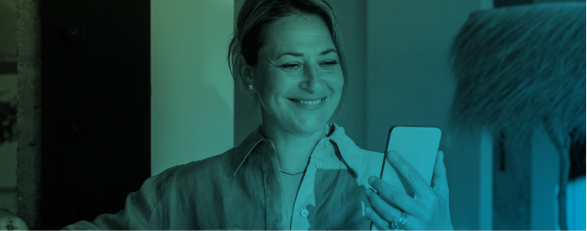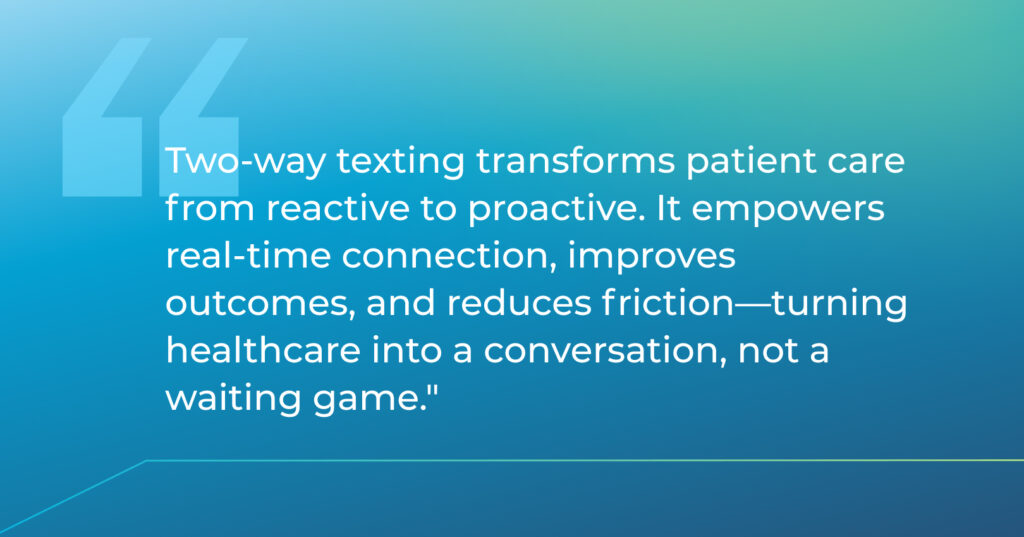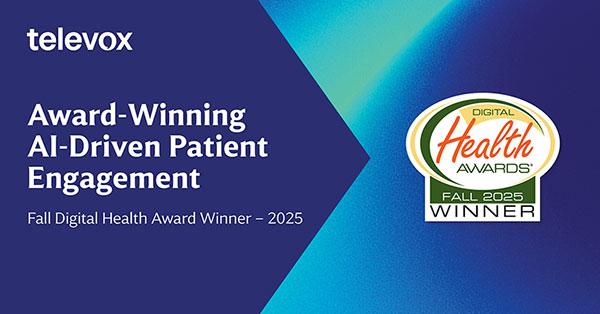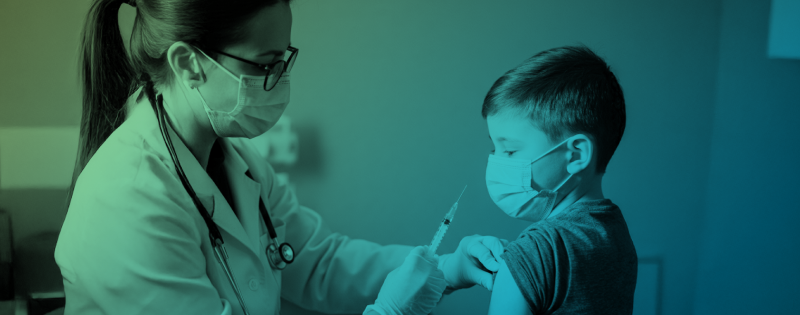Televox is proud to announce that its Enterprise Edition SMS solution has been awarded Gold…

The Importance of Patient Two-Way Text Messaging in Healthcare
What if a single text could prevent a hospital visit? The fact is that healthcare communication is evolving. One-way messages like generic updates are no longer enough. Patients want conversations, not notifications.
That’s where two-way text messaging comes in. It supports faster decision-making, early symptom tracking, and more responsive care. It’s also the new standard for how healthcare teams stay connected and keep patients healthier. Let’s dive into the importance of two-way communication in healthcare further.
How Does Asynchronous Two-Way Messaging Work in Healthcare
Unlike traditional synchronous communication, asynchronous messaging allows healthcare providers and patients to communicate without being online at the same time. Both parties can start, pause, and resume conversations at their convenience, removing the need for real-time interactions.
But in 2025, the key differentiator in two-way messaging is AI-powered inbound communication. Patients can reach out to the health system at any time via text or web chat. AI handles routine inquiries like appointment prep or prescription refills instantly. And when questions go beyond AI’s scope, the conversation escalates to a human agent, using a secure chat link sent by SMS or web.
This approach benefits both sides significantly. Providers can batch message responses rather than handling constant phone interruptions, while all communication stays documented in the electronic health record for better care continuity.
Patients can avoid phone tag and long hold times by sending symptoms via messages the moment concerns arise. This is done through a care program that’s fully integrated with the EHR, ensuring timely follow-up and continuity of care.
Not to forget that patients often prefer writing their concerns to think through questions completely. Hence, simple issues get resolved without appointments, freeing slots for patients who actually need in-person care.
Consider a healthcare provider receiving millions of annual messages from patients asking about blood pressure readings or medication side effects. The medical staff gets to maintain better continuity of care at high volumes without overwhelming real-time demands.
Benefits of Two-Way Texting for Patients and Healthcare Providers

Two-way texting with patients forms a direct, secure channel to their healthcare providers. It’s easy, faster, and far more efficient. Patients can ask questions whenever they want. With AI-driven tools, providers can respond when convenient without disrupting their clinical workflows.
Reduced No-Shows and Late Cancellations
The national healthcare sector loses millions on an annual basis due to no-shows. Two-way SMS messaging is an excellent way to address that problem. Automated systems can text reminders to patients a day or two (or even hours) before appointments to confirm.
Patients, in turn, can simply reply to a text to reschedule or cancel, all thanks to AI self-scheduling tools that integrate with the EHR or appointment management system, eliminating the need to call during busy office hours.
Faster, Real-Time Communication Between Visits
Using SMS updates to let providers know about symptom changes, healing progress, and any reactions without arranging calls is a big benefit for both sides.
Through structured care programs, providers can send brief instructions, lab result notifications, or post-visit care reminders in minutes rather than playing phone tag.
Consider a patient who is recovering from surgery at home. They can text photos of their stitches to be reviewed by the surgeon instead of making another clinical visit.
In another case, diabetic patients can text their blood glucose levels to confirm if they need to adjust their insulin levels instead of waiting for the next scheduled visit.
Reduced Staff Workload Leading to Efficiency and Productivity
You can’t expect the front desk staff to remain focused on in-house patient care when they are bombarded with phone calls all day long. Text messages remove that challenge.
The staff can instead schedule bulk text responses (appointment confirmations, basic questions, etc.) during designated times rather than being consistently glued to the phone. It’s a smarter, more sustainable way to work that helps reduce staff burnout.
Higher Patient Satisfaction and Engagement
Let’s face it: not everyone has the time or patience for phone calls, especially when juggling work, appointments, and daily life. That’s why more healthcare practices are turning to two-way HIPAA-compliant texting. It gives patients the freedom to reach out when it suits them: after hours, during a lunch break, or the moment a symptom shows up. It leads to a more relaxed, responsive, and engaged patient experience that naturally drives satisfaction scores higher.
Better Chronic Condition and Post-Visit Management
Patients with diabetes, hypertension, or heart conditions can submit daily health reports like blood pressure or glucose levels through structured care programs via text. These programs integrate with the EHR, giving providers consistent, actionable data to adjust medications and spot concerning trends early.
For example, some cardiac practices ask patients to report their weight each day via text. A small but sudden increase might indicate fluid retention, a red flag for worsening heart failure. With that early signal, providers can intervene fast and prevent a potentially serious setback.
Effective Communication for Both Hybrid and Remote Care Models
Remote care providers maintain regular contact with patients between video visits through secure text channels. Patients can report how new treatments are working or ask quick questions without scheduling full telemedicine appointments.
Hybrid care models combine in-person visits with ongoing text communication for continuous care management. Rural patients particularly benefit from this approach, maintaining a connection with specialists located hours away through regular text check-ins and updates.
Common Use Cases of Patient Two-Way Text Messaging in Healthcare
Two-way texting enables healthcare providers to engage patients more effectively. Below are some key scenarios where it shines in modern healthcare services.
- Appointment Scheduling and Reminders: You can forget about chasing patients by phone. Just sent text reminders that patients can easily (and quickly) respond to. Their one reply will automatically update your calendar, helping reduce revenue loss from empty slots.
- Intake Forms and Verifications: Text messaging provides a secure channel for eCheck-in, allowing patients to submit insurance details, consent forms, and pre-visit questionnaires, saving time for both sides.
- Billing and Payments: Text alerts with secure payment links facilitate collections at a mass level. Calling up each patient the old way is now not an effective tactic.
- Post-Visit Follow-Ups: Why bother patients with unnecessary follow-ups when they can simply check in via text through post-visit care programs? Physicians can review ongoing recovery, possible symptoms, and lab reports on the patient’s time.
Is Two-Way Texting With Patients Secure and HIPAA-Compliant?
The standard texting apps on your smartphone do not meet HIPAA requirements because messages are sent through unsecured networks and stored on multiple servers. These consumer-grade apps should always be avoided for healthcare messaging.
Hence, providers rely on specialized (custom) platforms that are built to encrypt messages, control access, and maintain audit trails. Such secure texting platforms create walled communication channels that meet federal privacy standards while maintaining the convenience patients expect.
HIPAA-compliant texting platforms involve signed agreements between both providers and platform vendors, ensuring both parties accept responsibility for protecting patient data. Your standard SMS apps don’t have such agreements, creating a void where no one is taking responsibility.
Key Features to Look for in a Two-Way Patient Messaging Solution
Choosing the right patient messaging platform requires careful evaluation of core features. Here’s what matters most when comparing options.
Security and Compliance
HIPAA compliance stands as the baseline requirement. It’s a mandatory box to check unless healthcare organizations are looking to open themselves up for violations and sanctions.
Check for end-to-end encryption, detailed audit trails, and user authentication methods. Your messaging system must secure all communication, prevent unauthorized access, and log all interactions for easier audits.
Message Automation Capabilities
Yes, text messaging is easy to do, but only through the assistance of automated systems. Otherwise, providers will just be writing texts all day long. The most effective messaging platforms provide automated confirmations, pre-visit reminders, and post-visit follow-up without the need for human intervention.
Integration With Existing Systems
There’s no point in investing in a messaging platform if it doesn’t play nice with your existing setup. Make sure your solution is compatible with your EHR so that forced integration doesn’t end up creating duplicate entries.
Reporting and Analytics
Track response times to identify bottlenecks in your communication workflow. Platforms should show average response times by staff member and message type.
Monitor patient engagement through read receipts and response rates. This data helps identify patients who prefer phone calls over text messages or need additional support navigating the platform.
Mobile Accessibility
Both patients and staff need seamless mobile access as part of a broader omnichannel experience. Native apps work better than browser-based systems for quick responses and notifications. Look for platforms that maintain full functionality across devices.
Push notifications alert staff to urgent messages without requiring constant app monitoring. However, notifications should be customizable to prevent alert fatigue.
Scalability and Pricing Structure
Consider your practice’s growth plans. Some platforms charge per provider while others bill by message volume. Smaller practices might prefer per-provider pricing, while larger organizations often benefit from volume-based models.
Test customer support quality during your trial period. The best platforms offer 24/7 technical support with actual healthcare communication specialists, not just general IT help.
Hassle-Free Two-Way Communication Integration With TeleVox
Stop juggling multiple platforms, wrestling with complex integrations, and losing patients in communication chaos. TeleVox transforms your patient messaging from a daily headache into a seamless, secure powerhouse that actually works the way your practice needs it to.
We provide HIPAA-certified communication solutions through SMS, voice, chat, and email, all integrated directly into your EHR system.
Let our AI-driven Smart Agent handle your routine interactions, allowing your staff to focus on patient care. Our proprietary automation tech fields all incoming texts and queries like appointment scheduling, prescription refill requests, or billing concerns around the clock.
Forget siloed apps, duplicated data, and additional training, and instead prioritize easy, secure two-way conversations that employees and patients can rely on. Schedule a demo today and discover how TeleVox can modernize your patient engagement strategy.




